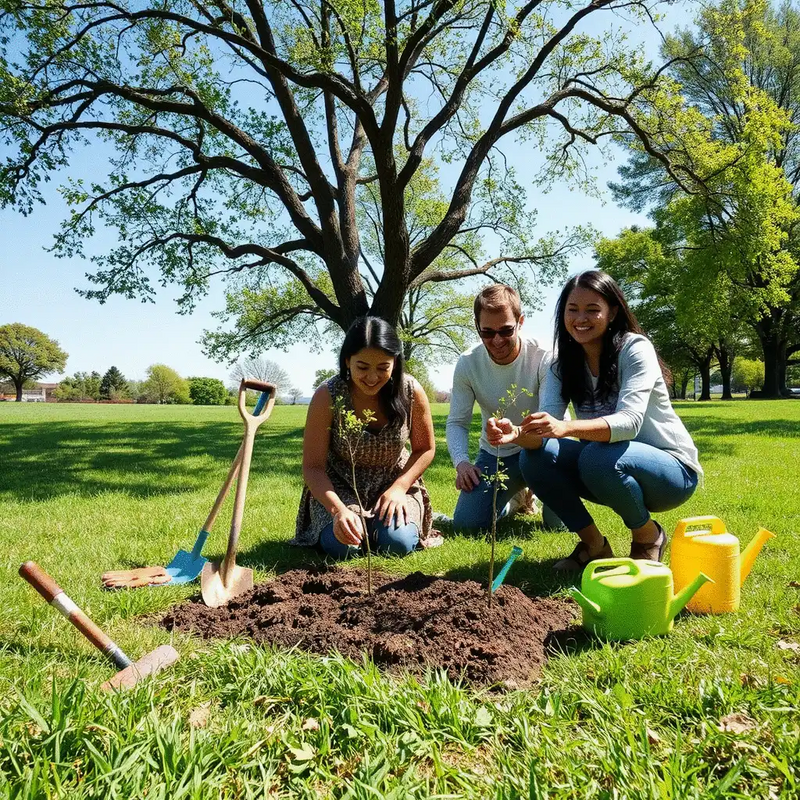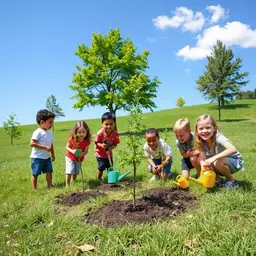Starting a Community Tree Project

Imagine transforming your neighborhood into a vibrant green space where the air is fresher and the community is thriving. Community tree planting initiatives are more than just environmental efforts; they are a pathway to creating connections among residents and fostering a sense of belonging.
What You Will Learn
- Community tree planting enhances the aesthetic appeal of neighborhoods, making them more attractive and inviting.
- These initiatives strengthen community bonds, fostering friendships and a sense of belonging among participants.
- Trees play a crucial role in improving air quality, providing shade, and promoting biodiversity in urban environments.
- Effective community engagement is essential for the success of tree planting projects, leading to greater participation and impact.
- Trees help combat climate change through carbon sequestration, improving soil health, and enhancing resilience against extreme weather.
- Planning a community tree planting project involves identifying locations, recruiting volunteers, and securing necessary permits.
- Access to local resources and expert guidance can significantly enhance the success of your tree planting initiatives.
Key Environmental Benefits of Community Tree Planting
The impact of community tree planting initiatives is multifaceted, addressing air quality, biodiversity, and climate change. Below are some key benefits summarized visually.
Air Quality Improvement
Trees filter pollutants, trapping harmful particulates and producing cleaner oxygen, enhancing overall air quality.
Biodiversity Support
Trees provide essential habitats for various species, promoting rich biodiversity crucial for a balanced ecosystem.
Carbon Sequestration
Trees absorb carbon dioxide, significantly aiding in the fight against climate change and reducing our carbon footprint.
Temperature Regulation
Trees provide shade, lowering urban heat and making cities more comfortable during warmer months.
Soil Health Improvement
Trees enhance soil quality and reduce erosion, promoting healthier ecosystems and landscapes.
Habitat Creation
Trees create habitats for countless species, supporting biodiversity and promoting ecological stability.
Understanding the Importance of Community Tree Planting Initiatives
Community tree planting initiatives are vital for fostering a sense of connection among residents while also enhancing our environment. By coming together to plant trees, we not only beautify our neighborhoods but also create a healthier ecosystem. It’s a fulfilling experience to witness the fruits of our labor as these trees grow and thrive, contributing to a greener future for everyone!
Benefits of Community Tree Planting Projects
There are numerous reasons why community tree planting projects are beneficial. They can improve air quality, provide shade, and even reduce energy costs by lowering temperatures in urban areas. Additionally, they create habitats for local wildlife, promoting biodiversity that is essential for a balanced ecosystem.
- Enhancing Aesthetic Appeal: Trees add beauty and charm to our neighborhoods.
- Strengthening Community Bonds: Working together builds friendships and a sense of belonging.
- Improving Mental Health: Green spaces are known to reduce stress and promote well-being.
At Timber & Thrive, I firmly believe that these projects can spark important conversations about sustainability and environmental stewardship. When we plant trees, we’re not just adding greenery; we’re creating a movement that inspires others to care for our planet.
Environmental Impact of Trees in Urban Areas
Trees play an essential role in urban environments, where concrete and asphalt can dominate the landscape. They act as natural air filters, trapping pollutants and providing us with cleaner air to breathe. Imagine a neighborhood where the air is fresher, and the temperatures are cooler thanks to the shade of lush trees!
- Carbon Sequestration: Trees absorb carbon dioxide, helping to combat climate change.
- Stormwater Management: Tree roots help absorb rainwater, reducing flooding and erosion.
- Temperature Regulation: Trees lower urban heat, making cities more comfortable during hot weather.
Through community initiatives, we can enhance the environmental impact of trees in our urban spaces. This is a step toward ensuring that future generations enjoy a healthier planet, filled with vibrant green life. It's important to choose the right native trees for planting to maximize these benefits.
Ecological Benefits and Climate Change Mitigation
Planting trees is a powerful act of environmental conservation that directly contributes to mitigating climate change. Trees absorb carbon dioxide, a major greenhouse gas, and store it in their trunks, roots, and leaves. By increasing our tree canopy, we can significantly reduce our carbon footprint!
- Habitat Creation: Trees provide homes for countless species, supporting biodiversity.
- Soil Health Improvement: Trees enhance soil quality and reduce erosion.
- Climate Resilience: More trees lead to increased resilience against extreme weather events.
By embracing community tree planting initiatives, we’re not just planting trees; we’re investing in a sustainable future. Each tree we plant becomes a beacon of hope and resilience, reminding us that every small action counts in the fight against climate change.
Quick Summary
Here's a brief recap of the key points discussed so far:
- Community Connection: Tree planting projects enhance community bonds and foster a sense of belonging.
- Environmental Benefits: Trees improve air quality, regulate temperatures, and support biodiversity.
- Climate Action: Planting trees plays a crucial role in mitigating climate change through carbon sequestration.
Frequently Asked Questions (FAQs)
Why is community tree planting important?
Community tree planting fosters connections among residents, enhances the environment, improves air quality, and supports biodiversity.
What are the benefits of planting trees in urban areas?
Trees in urban areas help filter air pollutants, regulate temperatures, reduce energy costs, and create habitats for local wildlife.
How do trees help mitigate climate change?
Trees absorb carbon dioxide, a major greenhouse gas, and store it in their trunks, roots, and leaves, helping to reduce our carbon footprint.
What are some key steps for a successful community tree planting project?
Key steps include engaging the community, identifying suitable planting locations, securing necessary permits, and choosing native tree species.
Where can I find resources and support for my tree planting initiative?
You can find support from local environmental organizations, online resources, community outreach programs, and workshops focused on tree planting and maintenance.
Summarizing Key Steps for a Successful Community Tree Planting Project
As we reflect on the journey of establishing a community tree planting project, it’s clear that success hinges on several key steps. First and foremost, engaging the community plays a vital role. The more people who feel connected to the initiative, the greater the impact we can achieve together! A community that shares a common goal is one that thrives.
It’s essential to reinforce the numerous environmental benefits that come from planting trees. By working with Timber & Thrive, I’ve witnessed firsthand how trees improve air quality, provide shade, and create habitats for wildlife. When we plant trees, we’re not just adding greenery; we’re fostering healthier ecosystems that can withstand climate change and urban challenges.
Highlighting the Importance of Community Engagement
Community engagement is the heart of any successful tree planting project. It cultivates a sense of ownership, instilling pride in participants. Here are some strategies that can help boost engagement:
- Host informational sessions to educate the community about the benefits of trees.
- Create engaging promotional materials that highlight the project’s goals.
- Organize fun, family-friendly events to attract more participants.
- Utilize social media to share updates and generate excitement.
By fostering a sense of belonging, we can create a lasting movement that inspires individuals to take care of their environment. Remember, engaged communities often lead to successful outcomes, and every tree planted is a step toward a greener future!
Reinforcing the Environmental Benefits of Tree Planting
The environmental benefits of planting trees are profound and far-reaching. Trees not only enhance the beauty of our neighborhoods but also provide essential services that support our ecosystem. Consider these key benefits: One of the most important services they provide is nurturing trees for healthier growth to ensure longevity and resilience.
- Air Quality Improvement: Trees filter pollutants and produce oxygen, making the air cleaner.
- Temperature Regulation: They provide shade, reducing urban heat and cooling our cities.
- Biodiversity Support: Trees offer habitats for various species, promoting rich biodiversity.
- Carbon Sequestration: Trees absorb carbon dioxide, helping combat climate change.
At Timber & Thrive, we believe it’s crucial to share these insights with the community to inspire action. When we understand the significance of each tree, we become motivated to participate in planting and caring for them. Together, we can amplify these benefits and ensure a healthier planet for generations to come!
Encouragement to Take Action and Start Your Project
Now that we've explored the importance of community engagement and the environmental benefits of planting trees, it’s time to take action! Are you ready to start your own community tree planting initiative? This is an exciting opportunity to make a real difference in your neighborhood!
Next Steps for Launching Your Community Tree Planting Initiative
The first step is to gather your team and brainstorm ideas. Engage local residents and share your vision for a greener community. Here’s a simple roadmap to guide you: Consider also the impact of deforestation's effects on local ecosystems, to emphasize the importance of your project.
- Identify potential locations for planting.
- Plan an informational event to recruit volunteers.
- Secure permissions and permits from local authorities.
- Choose native tree species that will thrive in your area.
- Organize the planting day and prepare necessary tools.
Each step brings you closer to creating a thriving green space that everyone can enjoy. Remember, every little effort counts, and your initiative can spark a larger movement.
Resources for Further Reading and Support
As you embark on this journey, it’s helpful to have access to resources that can guide your efforts. Here are some valuable tools and programs to consider: Don't forget to leverage sustainable urban tree care tips to ensure the long-term health and success of your community tree planting initiative.
- Local environmental organizations for collaboration and support.
- Online resources and guides about tree care and planting techniques.
- Community outreach programs that can provide assistance in promoting your project.
- Workshops focused on tree planting and maintenance offered by experts.
By utilizing these resources, you can enhance your knowledge and ensure that your project has the best chance for success. At Timber & Thrive, we’re here to support you on this journey and help you create a lasting impact. Let’s take those first steps together and turn our passion for trees into a reality! 🌳
Recap of Key Points
Here is a quick recap of the important points discussed in the article:
- Community Engagement: Building a sense of ownership and pride through involvement in tree planting initiatives is essential for success.
- Environmental Benefits: Trees improve air quality, provide shade, support biodiversity, and help combat climate change through carbon sequestration.
- Aesthetic and Health Benefits: Trees enhance the beauty of neighborhoods and contribute to better mental health and well-being.
- Key Steps for Successful Initiatives: Identify locations, plan events, secure permissions, choose native species, and organize planting days.
- Utilize Resources: Leverage local organizations, online guides, and workshops for support in your tree planting project.



